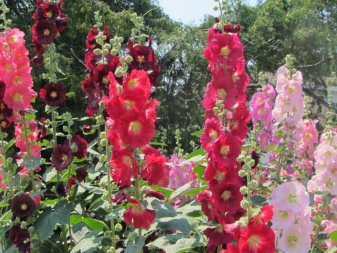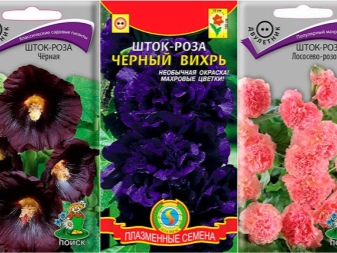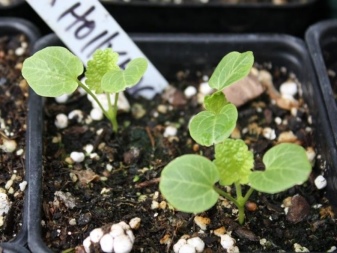Planting and caring for mallow

Mallow is one of the flowering crops loved by many gardeners. Most of them are spectacular tall plants, strewn with cup-shaped buds. There are also undersized, but no less beautiful varieties.
In addition to being highly decorative, the culture has medicinal properties. At the same time, she is unpretentious and does not need special care. We will figure out how to grow mallow in the country and what difficulties you may encounter in the process of caring for a plant.


Description
Mallow (stockrose) belongs to the Malvaceae family. There are about 30 varieties of this culture. The flower can be one or perennial. The maximum growth is 2.5 m. The plants have strong erect stems.
The color of the buds can be yellow, pink, red, purple, etc. Flowers of a burgundy shade, planted next to snow-white specimens, look especially impressive. The petals are regular and double. Flowering in perennials occurs in the second year and lasts half the summer (July and August), delighting summer residents.


Optimal disembarkation time
The plant can be planted in a variety of ways. The timing also depends on the choice of method.
- Seeds are placed in open ground in spring. You can do this both in May and early June. Seedlings can be seen after about a month.
- Sometimes sowing is done in autumn (September). In this case, the seed material is deepened more and it is qualitatively insulated before the onset of winter.
- Sowing seeds at home takes place in February or March. Seedlings are planted in the garden at the end of May.
- As for cuttings, the planting time depends on the method of obtaining them. Cut at the root are planted in spring. Stems are placed on the site in the summer.


Site selection and soil preparation
When choosing a place to plant in the garden there are a few key points to keep in mind.
- The site must be well lit. In partial shade, the plant will also develop, but the color of the buds will be pale and expressionless.
- The soil should be loose, nutritious. The presence of humus is encouraged. Light loam is a great option. Of course, don't forget about drainage.
- The accumulation of moisture at the roots of the plant is undesirable. This can lead to decay. Therefore, it is worth giving preference to flat areas with deep groundwater. Upland is fine too.
- If a high grade is selected, it is worth closing the culture from strong gusts of wind (you can plant a flower next to a house or a fence).
- A support for an adult flower is also recommended.
Mallow is sown on the plot after preliminary preparation of the land (digging and fertilizing). Heavy soil can be lightened by adding sand to it. And also it is worth waiting for some time so that the soil has time to "settle".

How to plant?
Depending on the method of planting mallow, agricultural technology also differs.
In open ground
Seed material is best purchased a couple of months before planting. So you will have time to test it for germination. Before sowing, the seeds are soaked in warm water (about 45 degrees). Enough 12 hours. The hard shell should soften. This will allow the seeds to germinate easily and quickly.
If sowing occurs in spring, the holes can be made not too deep. Enough 3 cm. The planting site is watered with warm water. Then 3 seeds are placed in each hole.
After that, future plants are sprinkled with a thin layer of fertile soil. You can use peat.The distance between flowers should be 35-50 cm. More precisely, this indicator is determined by the height of the plants. Large specimens require more space.
The planted mallow is regularly watered. You can cover the bed with plastic wrap - this will help the better development of plants. The first shoots will appear in 2-3 weeks. Then the film is removed and the flower care is continued according to the recommendations.
Perennial specimens grown on a plot of seeds delight with flowering in the second year. In this case, the mallow should be planted in the fall. Immediately after planting, the site is mulched.


Seedlings
Many grow mallow by seedling method. Experts advise placing the seeds in peat pots. This is an important point, since the culture does not tolerate transplantation well. Seed material is buried 1 cm. If sowing is carried out in ordinary containers, it is better to allocate a separate glass for each flower. It will be difficult to plant flowers from a common box.
After planting, the ground should be irrigated with a spray bottle. It is important to provide young plants with good lighting. Additional light sources may be required. Recommended air temperature - + 22 ... 25 ° С. A good solution would be to cover the plantings with transparent plastic. From time to time, the sprouts need to be ventilated, and the soil should be moistened.
Shoots appear in 10-14 days. When the seedlings grow up and get stronger, they can be hardened. Usually, the process begins a week before planting young flowers in the garden. To do this, containers with plants are put out on the street every day for a couple of hours. At the end, the time spent by seedlings in the fresh air increases to 4-5 hours.
At the end of May, each flower is transferred to the garden bed along with an earthen lump. At the same time, it is important to remember about observing the distance recommended by specialists.


Cuttings
This method allows you to guarantee the preservation of the varietal qualities of the crop. This is especially important when breeding hybrids. Some can only be grown this way, as their seeds are sterile.
Cuttings are taken from perennial specimens. If the procedure is carried out in the spring, the cut is made at the root. If the process takes place in the summer, the stem part is suitable. The length of the cutting should be about 10 cm. The cut is cut with charcoal.
The cut elements are left for a couple of hours to dry. Then they are planted in nutritious loose soil. After that, watering is carried out, then the planting material is covered with a transparent plastic glass. You can also use a plastic bag. Periodically planted cutting should be ventilated and watered.
Despite the seeming simplicity of the process, it should be understood that this method does not guarantee the survival of a new plant. Therefore, only florists with extensive experience use it.


How and when can you be transplanted to another place?
If we talk about transplanting an adult mallow, experts do not recommend doing this without a good reason. The fact is that the plant may not take root in a new place. Besides, there is a risk of damage to the large root system that can occur during the transplanting process.
If, nevertheless, such a decision is made, it is better to start the procedure at the end of August. Of course, this applies to perennial plants. It is advisable to transfer the flower along with a large clod of earth. This will help protect the delicate roots of the culture.

How to take care of it properly?
Like any plant, mallow needs care. Only by showing care can you grow a healthy and beautiful flower. Water the plant once a week. Each instance should consume about 5 liters of water. On especially dry days, more frequent watering is permissible (once every 2-3 days). The amount of moisture supplied to the ground can also be increased, but do not overdo it - from excess moisture, the root system of the flower can begin to rot.
Top dressing is necessary for the full growth and development of the plant. This is especially important if the mallow grows on infertile soil. After planting on the site, it is recommended to feed the seedlings with a solution of wood ash. Then every 3 weeks it is worth enriching the land with phosphorus-potassium compounds. In early summer, organic fertilizers can be used.
During the budding period, it is better to add complex mineral preparations to the soil. A useful addition will be herbal infusion.


It is imperative to remove weeds and loosen the soil. However, this must be done very carefully so as not to damage the roots. The tool must not be deepened more than 5 cm.
It is recommended to cut off the faded buds immediately. This will increase the plant's endurance, since it does not have to spend energy on seed formation. If you are going to collect seed material for the propagation of a crop, you need to do this after the end of flowering.
The need to tie tall specimens was already mentioned earlier. If you ignore this point, strong gusts of wind can break the flower stem. If there is a fence nearby, you can use it as a support. If the mallow is planted in an open area, you can dig a stick into the ground.


The flower is prepared thoroughly for winter. In September, the stems are cut. If you live in a southern climatic zone, you can leave about 30 cm of plants. Due to this, the shoots will appear earlier in the spring. If your winters are harsh, it is best to root the crop. And also the flower should be covered with a dense layer of foliage. In addition, spruce branches or special material are used.

Possible growing problems
Aphids and spider mites Are the most common threats to a flourishing crop. If pests are found, the flower must be treated with an insecticide. As for diseases, the appearance of powdery mildew is possible. A fungicidal solution can help here.
If the plant is sick leaf rust, unfortunately, it will not be possible to restore the affected areas. Leaves with ugly spots must be cut off and burned. Otherwise, the disease will spread and the mallow will die. To maintain immunity, the culture is treated with a Bordeaux mixture. Colloidal sulfur is also suitable.
When the flowering of the diseased plant is over, it is cut at the root and burned completely. The area where the flower grew is considered unsuitable for planting new mallow for another 3 years after an unpleasant situation.


Next, watch a video with expert advice on growing and caring for mallow.







































































































The comment was sent successfully.